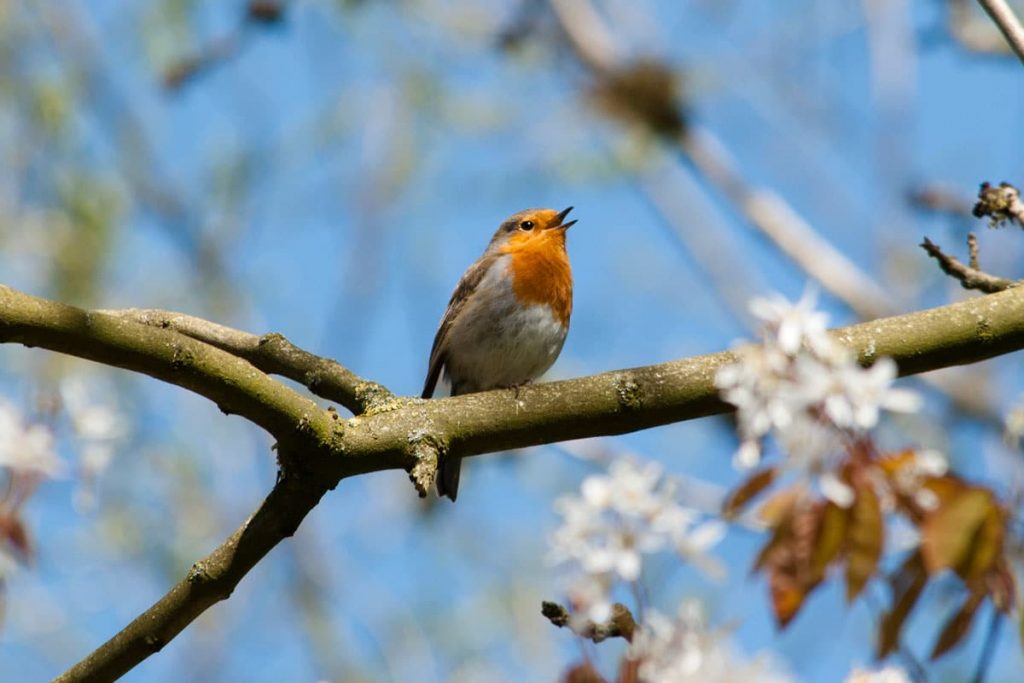Distinguishing females and males in robins is not easy, because size, plumage and song are very similar. With the right knowledge, it is nevertheless possible to notice differences.
To the point
- robins are difficult to distinguish by sex
- for an exact differentiation the age of the birds must be known
- nesting behavior but also plumage, measurements and song can be clues
- in the mating season and with offspring it is easier to differentiate males and females
Contents
Volume and song duration
The female birds of this species usually sing more softly and for a shorter time than the male representatives. Although they can sing almost as melodically as their male counterparts, the difference is still noticeable in direct comparison.
In addition, the songbirds can be heard primarily during the courtship season. The female Erithacus rubecula – as the bird species is scientifically called – sing then to draw attention to themselves and to animate the male conspecifics to feed.

Color and plumage
In young birds the feathers are brownish-gray. An orange breast develops later. From about the second year of life, the amount of gray on the breast of male Erithacus rubecula increases again. This causes the orange to rusty brown coloration to diminish and look more like a bib or collar.
With the female animals the color portion remains however the same. However, this factor serves as a distinguishing characteristic only when the age of the birds is known. Otherwise, a female robin cannot be distinguished with a young male.
Size
As with many other species, male birds are slightly larger than females. As males age, their chests become broader. As with plumage, comparison and knowledge of age is necessary for differentiation.
Feeding
Part of the courtship behavior includes the males feeding the females. If this behavior can be observed in two adult birds, the distinction is comparatively easy.
The male bird thus indicates that he can prove himself as a provider.
Raising the chicks
When the birds are breeding and the chicks have hatched, the mother bird remains almost entirely in the nest for at least two weeks. During this time, the male bird is largely engaged in providing food for both the young birds and the mother.
Thus, robins actively flying during the breeding season are usually males.
Territorial behavior
Furthermore, male and female robins can be distinguished by territorial behavior. Especially during the courtship and breeding season. Important points are:
- similar looking birds can be confused with Erithacus rubecula
- violent wing flapping while sitting usually occurs only in females
- males stay in one territory
- female birds stay primarily in nesting areas
Tip: If a bird repeatedly stays in the same area, it is most likely a male.
Nest building
Nest building involves both sexes, so distinguishing between them is difficult. However, knowing the position of a nest is helpful, because it allows to observe the birds for a longer time. To differentiate the respective sex of Erithacus rubecula is only possible with comparative certainty.
However, the birds build their nests in very different positions. For example:
Holes in the ground
hedges
Wall openings
Bushes
The nest is made of various materials, including:
- Feathers
- fur and hair
- Moss
- twigs and dried grass
Tip: The nests are usually close to the ground and resemble a bowl in shape.
Observation
Sustained observation is useful for differentiation. However, since the birds are very shy and territorial, this should not be done at close range.
Practical aids are therefore:
- Binoculars
- photographic images
- Game camera
Frequently asked questions
When do robins lay eggs?
The birds lay eggs once or twice a year. Therefore, the breeding season can last from April to August.
Are robins migratory birds?
Depending on winter temperatures, robins are migratory or resident birds. In northern Europe and in the east they are migratory birds, wintering in the Mediterranean.
Where do the birds breed primarily?
Forests with thickets as well as gardens with hedges and bushes are popular nesting places. Those who want to install nest boxes should position them close to the ground but protected from other animals.

